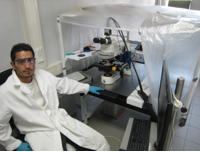
University:
Major:
Site Abroad:
Mentor(s):
Faculty Sponsor(s):
Project Title:
Project Description:
Convective assisted depositions of 2- and 3-dimensional arrays of micro- and nano-particles have been a topic of research for a significant amount of time. There has been a need to create consistent, closed-packed, ordered 2D particle arrays for current and future cutting edge applications. These applications vary from optical filters and anti-refractive surface coatings to data storage and micro-electronics. The overall project consisted on improving the micro-scale order of such 2D polystyrene latex submicro-, nano-particle arrays on wetting silica substrates. The project was divided into two parts. The first part consisted in the prevention of cracking in sub-micrometer (1 & 0.5 um) 2D particle arrays. Significant cracking appears upon drying of the films when the capillary forces overcome the repulsion forces between the particles. When the film is wet, there is a predefined distance between the particles; this distance is defined by the electric constant, E0, in the suspension which can be related and quantified/tracked through the pH. The capillary forces depend on the surface tension of the liquid which in turn depends on the contact angle. After several failed approaches, two kinds of approaches worked out. One of them resulted in significant improvement in the micro-scale order. The approaches taken were, changing the surface tension through surfactants, using volatile solvents, buffered suspensions, adding salts (ions) to change the Debye length, and changing the electric constant, E0, depositing at different temperatures. Of these, the latter two improved the order significantly when 1.0 and 0.5 micrometer particles were used. The optimum 2D arrays resulted from depositions near room temperature for pH values between 4.3 and 5.0. Adding the salts had the negative effect of solidifying and disrupting the ordered structure on the film. The other part of the project consisted in predicting the right deposition parameters for nano particle arrays based on deposition parameters using the 1 & 0.5 micro-particles. Quantitative analysis of particle speeds and wedge shapes depending on pH values, deposition temperature, and particle speeds were performed. Wedge shapes were fitted with a second order polynomial and found to be dependent on deposition temperature and pH value. Particle speeds were found to be dependent on temperature, slightly dependent on particle size and inversely proportional to the wedge shape. All these parameters were related to the localization energy, overall potential energy and kT energy of the particles. The ratio of these energies would help predict whether there would be order/disorder in the depositions. Depositions of nanometer particles are to be performed to prove or disprove the predictions.
